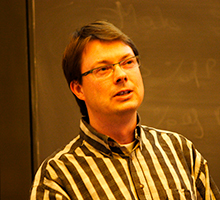Transformation has become a buzz word

We pave the way, as we go along. In the public sector, this is a phrase many will be familiar with and some will even have used it themselves. According to Professor and MPG Teacher Niels Åkerstrøm Andersen, the saying is very telling in terms of the development within the public sector, where change is replaced by transformation:
“Changes and reforms have been an integral part of the public sector. However, today, the talk is of transformation. And that is something radically different. Transformation indicates that everything must be transformed, including the place instigating the changes. Transformation has become a buzz word. When leaders speak of transformation, we pay attention. I would like to contribute by looking at what transformation does to us. To keep us from making it a matter of course,” he says.
According to Åkerstrøm Andersen, constant transformation brings much uncertainty, because public management feels required to uphold flexibility and indefiniteness in their work, as the level of complexity increases.
“With transformation, they try to create a present that will last for a long while. All options are kept open. Because the more present time there is, the longer they will have to combine the many elements that make up a complex public sector. A decision will, for example, be divided into steps. Think of a resource clarification process. You do not decide what the target is, because the target is what you examine along the way. And so, you maintain ambiguity while working.”
It is the same thing that happens with the numerous hybrids that spring up in the public sector. Niels Åkerstrøm Andersen defines hybrids as combining opposing identities. Something that cannot be combined, but is likely to be, regardless.
“Today, test actions are quite hyped within the public sector. A test action is an action that would rather not to be an action. It is saying that something is both an action and a non-action. It is a test action,” he explains.
We choose, rather than reject
According to Niels Åkerstrøm Andersen, hybrids express the way managers and staff are afraid to reject options. They always choose something, they never reject anything. And that is how we try to balance complexity.
Another example is partnerships. It is both a promise and a non-promise. Because as Niels Åkerstrøm Andersen puts it, partnership means promising each other something in the future.
“You also see it in contract management. Is it a contract or is it management? In legal terms, management is one-sided, while a contract is mutual. Thus, contract management is a hybrid of the one-sided and the mutual, and this renders the rules quite fluid.”
Managing self-managing staff members can also be used to illustrate what hybrids do: If a manager wants self-managing members of staff, the manager is issuing an order, according to Niels Åkerstrøm Andersen: Do as I say – be independent. He believes that this creates a zone of indefiniteness.
And then there are the intermediate forms.
“You can almost hear it, it’s a bit like expressing an aversion to choosing. Whether, by way of example, the child should be placed in an elementary school or a specialised school. With intermediate forms, you try to find the middle ground. But who should bear the discomfort of the complexity that is upheld? Is it the child, who will now have to handle being placed in an elementary school one day, only to be placed in a specialised school the next?”
In conclusion he states that:
“Having it both ways. That’s what hybrids entail.”
In his opinion, we are at risk of making hybrids a matter of course:
“That hybrids are great. That transformation is good. But when we take something for granted, we don’t see what it is doing to us. Partnerships come with a bag of promises about co-operation, dialogue and mutuality, but they also provide us with a paradox, where we promise to promise something at a later stage. Not standing by those effects can produce enormous amounts of frustration.”
Do not celebrate hybrids
He is very clear about one thing:
“I don’t want to provide a recipe: Stay away from hybrids. Instead, I would like to point to the fact that hybrids are created to help us adjust to a level of complexity, we can no longer handle. And with hybrids, we risk increasing chaos. Hybrids come with a price, and we have to talk about that, because it has an effect on us, our working life and the public sector.”
Niels Åkerstrøm Andersen would advise managers to break away from the matter of course.
“As a leader, you have to have the courage to contain the uncertainty the world holds, and to stand where there are no clear solutions in sight. Take responsibility for the disturbance that is produced and don’t pass it on through the system. Also, be careful not to celebrate hybrids. But ask: What price do we pay for organising ourselves in this way?”
That is why his research and a forthcoming anthology, “The politics of Transformation” co-authored by Åkerstrøm Andersen and a group of research colleagues from Copenhagen Business School investigate the term transformation.
“The old, classic word ‘reform’ means returning to the form. To recreate the original order. While transformation means changing the form. Finding a completely new form. And the ideal is constant transformation. It’s not a transformation from A to B. The goal is to be moving,” he explains, as he goes over the development of the public sector:
From 1860 until the Second World War, the state of law was oriented towards the past. When decisions had to be made, they would look to the past and draw on experience.
“During the 1960s and ‘70s, as we build the planning administration, we primarily look ahead. We analyse the future, and in doing so, we pull the future into the present as a premise for planning. Once we get to the 1980s, with the modernisation of the public sector, we look to the future. But in a new way. It’s not about estimating the future, it’s about seeing the future as a horizon of opportunities and challenges that leaders must prioritise.”
According to Niels Åkerstrøm Andersen, the idea of transformation begins to grow around the year 2000/2001, and today, time is split into a present, which is regarded as something that is constantly coming into being. The present is processes.
“On the one hand, we want a present that is not contaminated by the mires of the past. On the other hand, we don’t want a present that is linked to a particular future, because then we are stuck with that. The present has to be agile, flexible and fluid. The future is kept at bay. It becomes the future of the future. And when we look to the future, we do not merely look at a horizon, but also at what is on the other side of that horizon.”
Because there is no before and no after the transformation, the transformation is rendered a kind of void,” Niels Åkerstrøm Andersen says.
“Transformation implies that everything we are is wrong. Because what we were working on yesterday and the day before that, is already wrong. We are wrong. The way we organise ourselves is wrong. The only right thing is what is not yet here. This generates frustration. The more complex the public sector, the more opportunities it contains, but it also increases the risk of chaos.”
Structures and stability also have value
Niels Åkerstrøm Andersen opens up a debate on the value of structures and stability.
“We have to remember that structures are also the rule of law and professionalism and as such they are of value. When we implement transformative reforms that include radical deregulations, we are not necessarily creating more freedom, but rather more vagueness for both citizens who become increasingly unsure of what to expect and demand, and for the various professionals who are never quite sure when to contribute and when to stand back and let another profession contribute,” he says, and then continues:
“At the same time, the transformative reforms create a situation where all the experience that has been built up across many organisations and professions suddenly has no value and is merely regarded as being in the way of the new. This should be included in the equation when promising ‘new beginnings’ based on transformation.”
Contact
Niels Åkerstrøm Andersen
professor
Tel:+4538153664
E-mail: na.mpp@cbs.dk
Anne Katrine Gottfred Jensen
Journalist på master-programmerne
E-mail: akgj.master@cbs.dk
